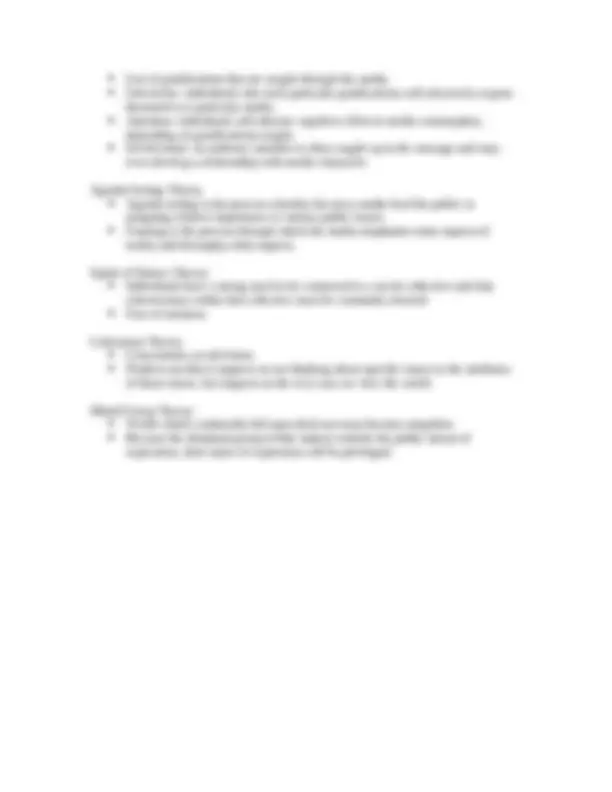




Study with the several resources on Docsity

Earn points by helping other students or get them with a premium plan


Prepare for your exams
Study with the several resources on Docsity

Earn points to download
Earn points by helping other students or get them with a premium plan
Community
Ask the community for help and clear up your study doubts
Discover the best universities in your country according to Docsity users
Free resources
Download our free guides on studying techniques, anxiety management strategies, and thesis advice from Docsity tutors
Material Type: Notes; Professor: Brown; Class: COMMUNICATION THRY; Subject: Communication; University: Radford University; Term: Fall 2008;
Typology: Study notes
1 / 4

This page cannot be seen from the preview
Don't miss anything!



Schema Theory Schemas provide ways of organizing information about the social world and provide guides for understanding and interaction. A schema begins whenever a person comes in contact with a new situation or idea. Schemas help to predict future interactions. Attribution Theory Looks for causal reasons that could be used to explain observed behavior. An internal attribution locates the cause of a particular behavior within the person and an external attribution locates the cause of the behavior in the situation. Narrative Paradigm Sees storytelling as the most basic and universal of all human activities. The world is a set of stories from which we choose and constantly re-create our lives. Dramatism Life is often played out in the dramatic tension of guilt and redemption cycles. Constructivism There is a creative emergent process of the social reconstruction of reality as involving an interplay of individual processes and socially and historically constituted processes and contexts. Constructivists are most interested in how people think about other people and relationships. Berger’s Theory of Planning When persons derive plans to meet goals, their first priority is to access long-term memory to determine whether an already-formulated plan is available for use. Cognitive Dissonance Theory Examines the relationship between attitude and behavior, the link between what you think about an issue and how you behave regarding that issue. We often maintain consistency in our attitudes by exposing ourselves only to messages that are consistent with our attitudes. Elaboration Likelihood Model Individuals are motivated (for social reasons) to hold “correct” attitudes. Attempts to explain different ways of processing messages, why different processing modes will be used, and the results of those processing modes on attitude change. Inoculation Theory
Deals with the processes through which we resist attitude change attempts that we might receive in interpersonal interaction or through the mass media. You perceive a threat and then refute it. Accommodation Theory Explain the ways in which interactants influence each other in the course of interaction. Accommodation refers to the ways in which individuals in interaction monitor and perhaps adjust their behavior during interaction. Expectancy Violation Theory We all have expectations about what interaction should and will be like. These expectations include behaviors such as distance during interaction, speech rate, volume, eye gaze, touching, and a host of others. Social Penetration Theory The theory is one that highlights the development, maintenance, and deterioration of social relationships. Relational development is viewed as a process. Orientation- individuals are cautious and tentative in their interaction, and these interactions are ruled by social conventions and formulas. Exploratory Affective Exchange- individuals begin to relax their guard a bit and share some information beyond the socially approved small talk. Affective Exchange- many barriers have been broken down and a great deal of open exchange occurs. Stable Exchange- continued openness and richness in interaction. Uncertainty Reduction Theory Models the process of interaction during the initial stage of relational development. People are driven by their desire to reduce uncertainty about each other. Incentives- we will be more likely to want to reduce uncertainty about an individual if we perceive that the individual can be rewarding to us. Deviation- if people act in ways that violate the norms of interaction, it increases our desire to know what is going on with that individual. Prospect of Future Interaction- if we know that we will be talking with someone in the future, we will want to reduce uncertainty about that individual. Relational Systems Theory Behaviors of individuals in a system are interdependent with and are often the response to, the behaviors of others. Positive feedback leads to change or loss of stability in the system whereas negative feedback preserves the status quo of the system. The concept of equifinality proposes that the same final state can be achieved through many different developmental pathways.
List of gratifications that are sought through the media. Selectivity- individuals who seek particular gratifications will selectively expose themselves to particular media. Attention- individuals will allocate cognitive effort to media consumption, depending on gratifications sought. Involvement- an audience member is often caught up in the message and may even develop a relationship with media characters. Agenda Setting Theory Agenda setting is the process whereby the news media lead the public in assigning relative importance to various public issues. Framing is the process through which the media emphasize some aspects of reality and downplay other aspects. Spiral of Silence Theory Individuals have a strong need to be connected to a social collective and that cohesiveness within that collective must be constantly ensured. Fear of isolation. Cultivation Theory Concentrates on television. Predicts not direct impacts on our thinking about specific issues or the attributes of those issues, but impacts on the very way we view the world. Muted Group Theory Words which continually fall upon deaf ears may become unspoken. Because the dominant group (white males) controls the public means of expression, their styles of expression will be privileged.